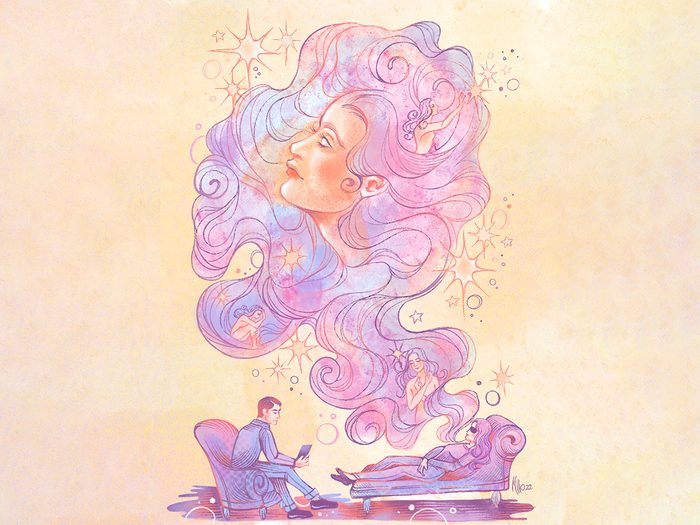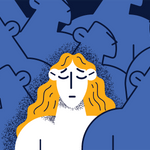An Expert Shares Everything You Need to Know About Psychedelic-Assisted Therapy

Can drugs like ketamine and magic mushrooms cure your depression?
Back in the 1950s and ’60s, psychiatrists prescribed therapeutic LSD to more than 40,000 patients as a treatment for alcoholism, anxiety and depression. And while the methodology might not have been as… rigorous as today, initial results were quite promising. “But then LSD escaped from the lab into the public, and there was a big clamp down under Richard Nixon,” says Dr. Emma Hapke, an attending psychiatrist at the University Health Network (UHN) in Toronto. “That kind of stopped research on psychedelics.”
But over the past two decades, decriminalization, destigmatization and dedicated researchers have helped usher in a psychedelic renaissance. Last year, landmark studies found that substances like MDMA can be combined with psychotherapy to provide considerable relief to patients struggling with PTSD and depression. And in January, Health Canada expanded its list of psychedelic drugs that doctors could apply for through its extremely strict Special Access Program (though just for patients facing “serious or life-threatening conditions”). “There is this knowledge that we’re sitting on these really powerful molecules, and it might be time to start studying them again,” says Hapke, who in October co-founded the Nikean Psychedelic Psychotherapy Research Centre at UHN, the first research centre of its kind in Canada. Here, she explains what exactly these drugs do, how psychedelic psychotherapy can help and why magic mushrooms still aren’t a magic bullet.
As a child of the late ’80s, I vividly remember the fried egg that was supposed to represent my brain on drugs. But what actually happens to our brains when we take psychedelics?
Molecularly, classic psychedelics—like LSD and psilocybin, the active ingredient in magic mushrooms—look almost exactly like serotonin. So when you take them, they bind tightly to serotonin receptors in the brain, and they quiet something called the default mode network. That network can almost be thought of as the conductor of the brain—it controls which parts communicate with each other. So when it quiets, parts of the brain that don’t normally communicate start to connect, and there can be significant changes in perception, emotion and thinking. For example, you might hear colours or see things outside the range of normal waking consciousness.
Psychedelics can also bring into your awareness stuff that may have been suppressed in your mind. So this could be past memories, past experiences, past traumas—and it brings them up because some of the typical defensive structures of the mind have softened. That can be very challenging in the moment, but it has the potential to be quite healing.
What goes on when you take MDMA?
When you take MDMA, which is the active ingredient in ecstasy, it not only causes a massive release of your own supplies of serotonin, but it also releases dopamine, norepinephrine, cortisol and oxytocin. MDMA quiets the fear-processing centre of the brain, so it reduces fear while keeping the person alert at the same time, which is very conducive to processing trauma. It’s also an empathogen, so it tends to increase feelings of empathy. That’s really helpful, because sometimes trauma survivors are stuck in a place that lacks self-forgiveness. MDMA really increases forgiveness and compassion for oneself and for others.
Do those feelings stick around even after the drug is out of your system?
For the trials of MDMA-assisted psychotherapy for PTSD that I’ve been involved with, we did three MDMA sessions over 18 weeks, and we found that at the end, 67 percent of people lost their diagnosis of PTSD. And when we followed up with people at the year mark, the same amount remained in remission.
(Related: Why I Celebrate My Birthday With Therapy)
And what do the sessions involve?
Generally there are three preparatory sessions, which is an opportunity for the therapist to get to know the patient and connect with them, because trust is really crucial for a successful outcome. Then there are the medicine sessions, which usually last anywhere from six to eight hours. Usually, for each dosing session, there will be three integration sessions, the first of which is typically the next morning. They’re really about making sense of what came up.
What if someone has a bad reaction?
I think it’s interesting to ask: How are we defining a bad reaction? With classic psychedelics, there can be an experience called ego dissolution, which is when your typical sense of self starts to dissolve. That can be quite scary for people because they’re losing control. But we do a lot of work to prepare them for that, and we coach them to continue to breathe—and to trust that even if it’s scary, it’s actually part of the process of significant healing and change. Facing what they’re afraid of gives people a sense of mastery.
How is this sort of psychotherapy different from more traditional forms?
In some ways, there’s an unlearning for therapists, because you are less active and you intervene less than in other forms of psychotherapy. You’re creating a safe space, but then you need to learn to sit back and allow self-healing.
So does the therapy amplify the effects of the drugs?
I really think about psychedelic healing as a triangle. At the top, we have the therapeutic modality, which is what you do in those preparation and integration sessions. On one side, we have the drug effects. And on the other side, we have the therapeutic relationship, which is incredibly important. They all work together. At the same time, we’re starting to see really interesting research about how you might combine different types of therapy with different psychedelics to treat different conditions.
(Related: How to Find the Best Therapy App for You, According to Experts)
Maybe cognitive behavioural therapy goes really well with mushrooms?
There’s a study at Remedy Institute in Toronto combining a trauma-based CBT with MDMA. There’s another form of therapy called ACT, which is acceptance and commitment therapy, that’s been studied at Yale where they combined it with psilocybin for depressed people. We’re also seeing lots of emotion-focused therapy be combined with ketamine. But I think it’s too early to conclude anything. People have really high expectations for psychedelic-assisted psychotherapy, but I tell people it’s not a magic bullet. It catalyzes therapy for people who are ready to go deeper. But it’s ongoing work, and if people aren’t yet ready to do that work, it can set them up to be disappointed with the outcomes.
What is the state of psychedelic psychotherapy in Canada right now?
It’s still very early days. There have only been a handful of clinical trials, but that’s rapidly expanding. The Canadian Institute for Health Research put out a specific call for funding for psilocybin trials, so that’s exciting. We’re seeing much more research and training programs emerge in universities across the country. In terms of what’s actually legal, it’s really mostly ketamine. There are private clinics that offer ketamine-assisted psychotherapy.
Why is ketamine already allowed?
It’s been previously approved by Health Canada as an anesthetic. So we know it’s safe, and it’s had this pretty strong effect in terms of treating depression and suicidality. What’s different, though, is that the effects of it might wear off, so some people need ongoing treatments. With MDMA, we have seen results continue in about two-thirds of patients—it’s been studied in veterans, who have this high burden from war. They’re able to process a lot of it through MDMA therapy, and then they tend to get better and stay better. With psilocybin and depression, it’s much less clear, so we need more research on how we improve the integration period. Maybe people need occasional booster sessions.
Are there challenges in that research?
In typical clinical trials, you blind people, so they don’t know if they’re getting the active drug or a placebo. With psychedelics, it’s really hard to do that, so our traditional double-blind randomized control trial model doesn’t necessarily fit. That’s something we’re trying to figure out.
What else are you working on at the Nikean Psychedelic Psychotherapy Research Centre?
We really envision that it’ll have three pillars. One is research, one is education, and then more clinical work down the line, once these medications become regulated. We’re starting our first clinical trial soon for patients working through end-of-life distress, combining psilocybin and psychotherapy. We’re also going to pilot that with caregivers, because they often have even higher levels of distress. And for people who have had complicated bereavement, we’re curious if psilocybin-assisted therapy would help. That’s one of our first big projects. And we’re working hard on launching a training program for therapists, with the first cohort launching in September 2022. People need really good training in order to be able to do this in a safe way. I do think, though, that the University Health Network being open to this research and work sends a signal to Health Canada—and to the general public—that it’s an area worthy of rigorous scientific exploration.
This interview has been condensed and edited for clarity.
Next: Magic Mushrooms for PTSD: Why Psychedelics May Help Heal Trauma




